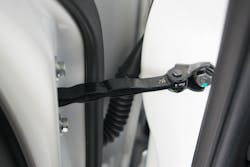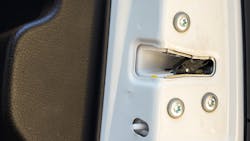Preventive maintenance for commercial vehicle doors and locks
It’s no secret that last-mile delivery and regional haul operations have been on the rise in the transportation industry. As such, it is fair to assume that the cycle rates for vehicle doors, latches, locks, hinges, and related components have increased alongside the growth of start-stop vocations in comparison to on-highway applications.
While onboard vehicle technologies and the use of telematics have seen widespread adoption, there seems to be an uncaptured data set pertinent to last-mile and regional duty cycles: cycle rates on door hinges, locks, and related systems. If a fleet is increasing the number of times a driver enters or exits a vehicle, opens and closes cargo doors, or engages and disengages locks, it is up to the maintenance department to make sure that all systems remain functional to maintain the safety of operator and cargo alike, all the while ensuring vehicle uptime and the mitigation of system failures.
Monitoring usage
The Technology and Maintenance Council’s (TMC) Recommended Practice (RP) 424 Door Hardware Performance Requirements establishes the minimum performance requirements for door hardware used on heavy-duty vehicles. As stated in this RP, TMC advises the seals, latches, handles, locks, and more to remain fully functional for a minimum of one million miles for on-highway applications.
For duty cycles other than on-highway operation, such as last mile or regional, the RP suggests thresholds should equate to a time period of four years based on the average expected cycle use of such devices in those vocational conditions.
Furthermore, RP 424 states that performance validations should include—but are not limited to—strength, dust resistance, vibration resistance, ozone, corrosion resistance, low and high temperature evaluation, chemical resistance, and water resistance. It also suggests that components such as door seals be evaluated in conjunction with the mating surfaces that they are fitted between during normal use.
Though RP 424 is intended to establish guidelines for heavy-duty on-highway operations, it is a good reference point for maintenance personnel who monitor cycle rates on last-mile and regional commercial vehicle doors and related hardware. However, in order to ensure that such systems are functioning as intended and are not nearing end of life or imminent failure, some fleets may look to capture more accurate data to get a better understanding of the actual cycle rates and functionable timeline.
David Kegley, director of training and development at Ryder System Inc., said that currently, “There’s nothing that we are using today that tracks that piece [of data] that says this is how many times a door opens and closes.”
However, in brainstorming with people in Ryder’s Technical Assistance Center, Kegley related that the door does contain a switch that actuates the dome light within the cab. It would be possible to track that information and use it to accurately assess the number of times a vehicle door is opened and closed.
“If we had that data, we could use it the same as we do for starters or really anything that you think about when we start changing it by cycle time,” Kegley said. “We know that there is a limited life to any mechanical piece of equipment. Depending on how it is used or abused could change that a little bit, but there’s always that limit. And if we knew what the limit was [for doors and related components] and we could measure it, you could always get ahead of things.”
Another method for tracking cycle rates is to correlate door usage with ignition cycles, explained Shiva Bhardwaj, CEO of Pitstop, a software solution provider that implements vehicle data and predicitve analytics to improve fleet uptime.
But artificial intelligence isn’t required to get ahead of door issues.
“A lot of it comes down to physics,” he said. “People think it is some sort of complex algorithm; it’s actually quite simple.” Bhardwaj related how a last-mile delivery fleet came to Pitstop for insight into failing cargo door hinges on their vans.
“We looked at the ignition cycle, on and off, because you couldn’t get that back door opened and closed [without cycling the ignition],” h Bhardwaj said. “We correlated, ‘Typically, in your fleet when your ignition cycle hits 400 or 500, then there’s a likelihood that this hinge is getting weaker. So, on the next inspection, tell the tech to check it out. Do you notice that the hinge is bending?’”
He noted that a door failure leads to vehicle downtime and higher costs for the fleet.
Bhardwaj added the computer-aided method works because it’s purely “data analysis, and it’s giving an insight in a way that you can’t get by manually trying to analyze this data.”
For delivery fleets, having a precise measurement of stops and packages could also be used to monitor cycle rates on doors and hinges.
“Tracking the usage rates on doors and locks starts with your understanding and accuracy of the stops your drivers are making,” suggested Angelo Cinquegrana, AVP of field operations and GM for Amerit Fleet Solutions (AMS). “You have to know how many stops and roughly how many packages are going to each location. If you know the number of stops, you can determine how many times it’s necessary to open and close doors, locks, and hinges.”
Seeing the signs
The good news is that immediate and catastrophic failure of such systems is rare. Rather, there are warning signs that the maintenance department and vehicle operators should be aware of that could point toward service and repair needs.
The number one indicator of need for service is noise.
“If there’s ever noise opening the door … think about a driver having to open and close that door multiple times a day … that can get a bit annoying,” Kegley related. “Noise is actually one of the bigger complaints that we have when we start identifying things.”
Another top identifying factor is looseness. Door handles or hinges that feel loose are another indicator that service is needed.
“You may need to put more effort into opening or closing the door,” said Dirk Woerpel, manager, Ford Pro NA marketing and strategy. “Doors are meant to be tight fitting; if it doesn’t feel smooth and tight, it may be a sign that a part is wearing out.”
Kegley recommended paying special attention to latch adjustments during installation or repair to avoid looseness.
“The latch itself has an adjustment to it. And when you replace either side of that, you’re going to want to make sure that it is adjusted so that the door stays snug,” he said. “If you read through the manuals, most of them use the word ‘firm.’ It has to close ‘firm’ and stay snug. If it’s loose on the seal, it’ll rattle, and that’ll cause extra wear. Any time any of the hinges or the latches are replaced, even if they’re removed for some other repair, when you put those back on again, you want to make sure that door has a firm feel when it closes, and it’s snug when it’s latched so it doesn’t vibrate.”
Cinquegrana recommended replacing the latch and lock in sequence, together.
“You don’t always need to replace the hinge with it, but if you’re replacing any pieces that interact together, it’s a good tip to replace all the pieces at once so they continue to interact well together,” he explained. “Replacing a worn piece and keeping a semi-worn piece can temporarily solve an issue, but it won’t fix the problem entirely.”
Cinquegrana also noted that keeping an eye on usage patterns may help fleets identify abuse or neglect.
“If Driver A makes 30 stops less than Driver B, but Driver A is seeing more wear and tear on the doors, locks, and hinges, that could indicate misuse in some capacity or some type of part failure,” he said. “More important than how frequently your drivers are using the doors and locks is how your drivers are treating those assets.”
When a fleet spots warning signs of failure, good technicians will want to diagnose the root cause. The most common culprit in this case is a lack of lubrication.
“The most important thing is lubrication,” Kegley emphasized. “Lack of lubrication is definitely the death of any of those components. Abuse is always there, but lack of lubrication is probably the key thing that we see when we see the failures.”
There are, however, other tips that drivers and technicians should be aware of to avoid unnecessary wear and tear on door components.
“Encourage drivers to treat a vehicle as if it were their own,” Woerpel offered. “What we’ve found in working with many last-mile delivery companies is that drivers are under pressure to deliver a lot of packages in an eight-hour shift. Often, the driver will get out of the vehicle and let the door slam closed on its own. This creates more wear and tear on the hinge and door stopper than usual, and it can cause these parts to wear out more quickly. Sometimes, the driver kicks the door open, putting strain on the door’s hinges. It’s similar for the sliding doors. Often, a driver will hop from the front seat to the back, grab a package, and go out the sliding door, closing it with a heavy slam.”
Woerpel also explained that Ford Pro Telematics software offers in-cab coaching capabilities for support in helping to manage and change operating behaviors.
“Connected vehicle data, sensors, and technology that learns driver behaviors to adapt vehicle performance are all going to play a part in helping to prolong the vehicle lifecycle long term,” he said.
The low-tech solution?
“The best practice to avoid abuse or misuse is to slow down and open, close, and shut latches, locks, and doors appropriately,” Cinquegrana noted. “Avoid slamming doors, kicking doors open, and knocking doors shut, for example.”
“[These components] live pretty long without the abuse of flying wide open or getting rattled loose,” Kegley agreed.
Also, ensure the door is closed before moving the vehicle.
“We found that there are a lot of incidences where somebody thinks they are just going to back up a little bit and they have the door open, and when they back up, the door gets caught on something,” Kegley said. “Don’t move the vehicle with the door open. It sounds simple. It sounds funny. But it has caused some situations.”
Another measure to prevent unnecessary wear on doors and their components is to avoid stacking packages against the door, hinges, latches, etc. Cinquegrana suggested operators keep the surrounding area of the door free and clear so that unwanted pressure from the weight of the packages is not applied to any door components.
Lock-tight preventive maintenance
The key to uptime, in this instance, is thorough and consistent preventive maintenance. Doors, locks, hinges, and other related components should—if not already—be accounted for in a fleet’s PM inspection list. And beyond maintaining the vehicle, maintenance costs can also be adequately controlled through rigorous PM, as Ryder’s Kegley attested.
“We actually went through and looked at the cost of replacement door handles,” he said. “Think about how last mile has really kicked up in the last two to three years. When we went back and looked at the cost that we’re having per vehicle, just average cost of door components, we’re pretty much flat. We’re just a little bit lower than what our cost was per vehicle in 2018. Even with the high usage, and the fleet count which has gone up about 30%, the cost per vehicle right now is still pretty flat with where we were before in that field.”
Kegley adamantly attributed this to Ryder’s preventive maintenance practices.
“We schedule our trucks for an interval, and part of that PM inspection is the door, locks, catches, hinges, all that stuff,” he said. “As long as we maintain the same preventive maintenance practices that we’re doing and pay attention to those when we do replace it, I think we’re going to stay right there.”
The maintenance team’s strategy should be to use all the tools and information available to best structure the PM to account for the door system in its entirety.
“While we design vehicle doors and hinges to last for the life of the vehicle, fleet managers can add a visual inspection of doors, locks, and hinges to a regularly scheduled maintenance program, for example, every 10,000 miles,” Woerpel said. He continued, stating that the Ford Pro Telematics app is one tool fleet maintenance management can use to track physical inspections prior to vehicle operation, “which can help to track emerging maintenance needs.”
TMC’s RP 1401 Cab and Body Preventive Maintenance Inspection Procedures is another tool fleets can use to structure their PM. This RP offers a standardized preventive maintenance procedure for truck bodies using a checklist that covers many light- and medium-duty vehicles. It is just one section of what should be a comprehensive PM manual for light- and medium-duty vehicles but can point maintenance teams in the right direction to establish guidelines when addressing doors and related systems and components.
The RP itself does not provide specific time or mileage intervals to which such PM inspections should be taking place. Rather, such intervals should be determined by maintenance management based on vehicle specification, application, OEM and component manufacturer recommended intervals and warranties, and vehicle maintenance history.
RP 1401 details specific steps technicians should take, along with points and components of emphasis to be focused on, when performing a PM pertaining to the door system. Most importantly, the RP suggests that technicians lubricate all door latches, hinges, and locks during the PM.
“The best preventive maintenance practices for doors and locks are to keep them well lubricated, especially in colder climates, to help prevent rusting, collecting of water, or freezing,” Cinquegrana stated. “During every PM, these locks and latches should be lubricated.”
“Lubrication is the secret to longevity,” Kegley agreed. He related that Ryder uses a single food-grade lubricant across its fleet—whether it is for the rear doors or side doors, because they want to accommodate anything that customers may be hauling inside the vehicles.
AMS prefers to use white lithium grease on locks and latches, Cinquegrana explained.
“In colder climates, white lithium grease can make a drastic difference in preventing wear and tear on locks and latches,” he said, adding that AMS uses WD-40, or “something similar,” when lubricating hinges.
And during a PM, the experts suggested replacing dirty or old lubricants without hesitation.
“If it is dirty, we clean it with a cleaning solvent,” Kegley said. “But looking at what we’re seeing, it’s mainly as long as we keep them lubed at the intervals, we get pretty good life out of them.”
Whatever a fleet’s strategy for monitoring usage or their capacity to see the warning signs for service in the doors, latches, and hinges, what is most important is adherence to a thorough preventive maintenance schedule.
“Do the basic things right, and you’re gonna stay okay,” Kegley surmised.
Technology and Maintenance Council Recommended Practice 424 Door Hardware Performance Requirements
TMC RP 424 establishes the minimum performance requirements for door hardware used on heavy-duty vehicles. TMC expects the following list of door hardware and components to remain fully functional for a minimum of one million miles in on-highway applications.
- Seals
- Latches
- Handles
- Hinges
- Linkages/rods
- Springs/clips
- Locks
- Window lift mechanisms (either manual or powered)
- Screws
- Knobs
- Switches (door mounted)
- Electrical connections
- Mirror mounts
- Armrests
Technology and Maintenance Council Recommended Practice 1401 Cab and Body Preventive Maintenance Inspection Procedures
TMC RP 1401 offers a standardized preventive maintenance procedure for truck bodies using a checklist that covers many light- and medium-duty vehicles. It suggests that, when performing a PM on doors, technicians should:
- Check for ease of operation. Lubricate rollers and slides.
- Check spring counterbalance for attachment and operation.
- Check locks for proper operation.
- Check condition of seals. Replace any that are worn or torn.
- Check that doors close and latch tightly.
- Check overhead door tracks for secure mounting and condition of channels. Lubricate rollers.
- Check rear door cables for secure attachment and fraying. Replace any frayed cables.
- Check door panels (inside and outside) for any signs of leakage. Replace seals as needed.
- Check door strap for secure mounting. Check for fraying, wear, or weak spots.
- Check door strap for attachment per manufacturer’s recommendations.
- Lubricate all door latches, hinges, and locks during the PM.
About the Author
Tyler Fussner
Associate Editor | Fleet Maintenance
Tyler Fussner is Managing Editor - Community Manager at Supply Chain Connect, part of the Design & Engineering Group at Endeavor Business Media.
Previously, Fussner served as the Associate Editor for Fleet Maintenance magazine. As part of Endeavor's Commercial Vehicle Group, his work has been published in FleetOwner magazine, as well as Bulk Transporter, Refrigerated Transporter, and Trailer-Body Builders.
Fussner's May 2022 print feature 'The dawn of hydrogen trucks' was named the best single technology article in B2B by the judges of the 2022 Folio: Eddie and Ozzie Awards. Fussner was also awarded Silver in the Technical Article category for the Trade Association Business Publications International (TABPI) 2021 Tabbie Awards.
Fussner previously served as Assistant Editor for Endeavor's Transportation Group on the PTEN, Professional Distributor, and VehicleServicePros.com brands.
Fussner studied professional writing and publishing at the University of Wisconsin-Whitewater. He has experience in shop operations, is a Michelin Certified Tire Technician, and a Michelin Certified Tire Salesperson.





